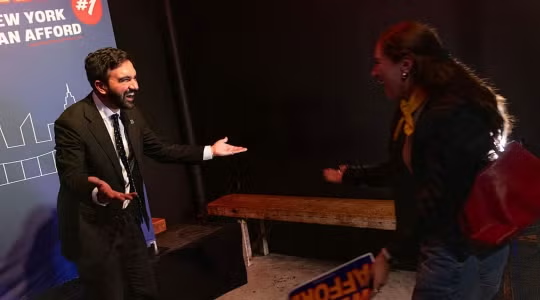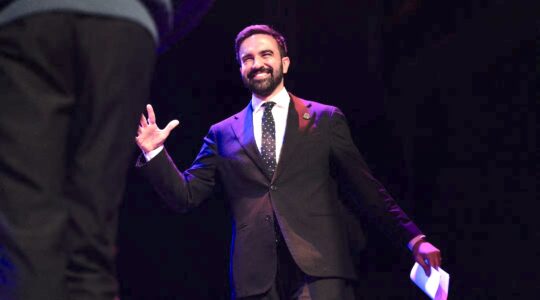Sukkot bears within it an essential tension. On the one hand, it is the time of simchateinu, our rejoicing, as the holiday liturgy underscores; it is also a high point in the agricultural cycle, with abundant harvests of early fall. At the same time, the sukkot we construct for the holiday serve to remind us of the fragile existence of all those homeless years wandering in the desert.
Or does the sukkah of Chag Sukkot commemorate a different event entirely?
An important strain in the thought of Chazal suggests that the sukkot to which our holiday refers are not the physical, spare desert huts. Rather, they refer to the ananei haKodesh, manifestations of the Divine Presence that encircled and protected Bnei Yisrael after they left Egypt (Sukkah 11b, with parallels elsewhere). This understanding is advanced by Rashi in his commentary on the passage, and he repeats it emphatically elsewhere. In this view, Sukkot is indeed joyful—and, notably, free of tension.
According to this view, the sukkah is a painful reminder of the contingent nature of human life, even as we enjoy the last good weather and seasonal produce.
But other Tannaim contend that the sukkot we build are indeed intended to represent the temporary dwellings in which our ancestors had to live. According to this view, the sukkah is a painful reminder of the contingent nature of human life, even as we enjoy the last good weather and seasonal produce. This perspective is supported by a midrash (Yalkut Shimoni BeMidbar 29) which relates that the holiday of Sukkot was originally intended to occur in the summer month of Tammuz, with its agricultural plenty and assuredly good weather.
However, after the sin of the Golden Calf, which took place in Tammuz, Sukkot was postponed along with the rest of the planned summer holidays, all of which were relocated to Tishrei.
To this I would add the transgression of the Meraglim, which consigned the Generation of the Wilderness to wander those forty years, extending the years they dwelled in sukkot. Not only was the assured comfort of this joyful holiday attenuated by sin, the insecurity of living in temporary shelters was extended, which we are called to experience viscerally.
From this perspective, how are we to understand both the importance of rejoicing and of remembering our desert wanderings? This tension is precisely what makes the holiday so compelling.
Our sukkot are reminders of what should have been. Dwelling in the sukkah, we reenact an exilic state born of transgression. Seen this way, celebration and contrition, abundance and fragility are bound together in the symbolism of Sukkot.
From this perspective, how are we to understand both the importance of rejoicing and of remembering our desert wanderings? This tension is precisely what makes the holiday so compelling.
The wildness years—those of Bnei Yisrael, and our own—are lean and difficult years. They are a period of dissolution: things come apart and never exactly come back together. They build character, but only for the collective; for the individuals, well, they’re on a journey the destination of which they’ll never reach. Freed (benei horin) they may have been, aval lo ata ben horin libatel mimena., but they are not free to desist from their wandering. I think it’s we too who do our living here, in the wilderness, believing in a promised land we can only keep moving towards—not without intercession (sometimes of the meltdown variety), bouts of despair for some of us, all-out rebellion for some of us, succumbing to doubt, breaking our promises just as soon as we’ve made them, forgetting what we’re doing this for, thinking we’ll do anything for a hot cup of coffee.
The narrative of the Torah never takes us into the promised land, out of temporary shanties and into settled homesteads; we’re left bereft on the far side of the Yarden.
The narrative of the Torah never takes us into the promised land, out of temporary shanties and into settled homesteads; we’re left bereft on the far side of the Yarden. We mourn Moshe and then immediately roll the scroll back and read, again, from BeReshit, arriving where we started, still not knowing the place for the first time. Only Yehoshua can take us into the Land, and that is Nevi’im already, which holds a significant, but separate, place in our liturgical and learning cultures.
We must hold the promise in our minds all that time as we travel from the primal moment of creation through slavery and revelation to gaze at the promised Land from the outer bank once again. For all our integrity and efforts, it may well lie beyond our grasp. Sukkot does not deny us the difficulties; it acknowledges them, and urges us to keep going.
Posts are contributed by third parties. The opinions and facts in them are presented solely by the authors and JOFA assumes no responsibility for them.
If you’re interested in writing for JOFA’s blog contact dani@jofa.org. For more about JOFA like us on Facebook or visit our website.
The New York Jewish Week brings you the stories behind the headlines, keeping you connected to Jewish life in New York. Help sustain the reporting you trust by donating today.




